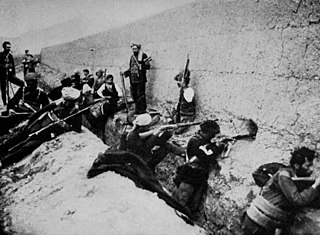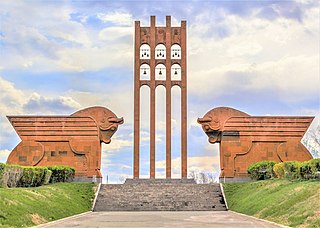 W
WThe Battle of Bash Abaran was a battle of Caucasus Campaign of World War I that took place in the vicinity of Bash Abaran, in 1918. The Armenian victories at Bash Abaran, Sardarabad and Karakilisa, halted the Ottoman invasion of Eastern Armenia and were instrumental in allowing the formation of the short-lived First Republic of Armenia.
 W
WThe Battle of Baku was a battle in World War I that took place between August–September 1918 between the Ottoman–Azerbaijani coalition forces led by Nuri Pasha and Bolshevik–Dashnak Baku Soviet forces, later succeeded by the British–Armenian–White Russian forces led by Lionel Dunsterville and saw briefly Soviet Russia re-enter the war. The battle was fought as a conclusive part of the Caucasus Campaign, but as a beginning of the Armenian–Azerbaijani War.
 W
WThe Bergmann Offensive was the first engagement of the Caucasus Campaign during World War I. General Georgy Bergmann, commander of I Caucasian Army Corps, took the initiative against the Ottoman Empire.
 W
WThe Battle of Binagadi was a battle in World War I that took place between 26 and 31 August 1918 between the Ottoman–Azerbaijani coalition forces led by Nuri Pasha and the British–Armenian–White Russian forces led by Lionel Dunsterville and saw briefly Soviet Russia re-enter the war. The battle was fought as an important part of the Battle of Baku.
 W
WThe Battle of Bitlis refers to a series of engagements in the summer of 1916 for the town of Bitlis and to a lesser extent nearby Moush, between Russian Imperial forces and their Ottoman counterparts. The town was the last stronghold of the Ottoman Empire preventing the Russians from entering Anatolia and Mesopotamia.
 W
WThe defense of Van was the armed resistance of the Armenian population of Van against the Ottoman Empire's attempts to massacre the Ottoman Armenian population of the Van Vilayet in the 1915 Armenian genocide. Several contemporaneous observers and later historians have concluded that the Ottoman government deliberately instigated an armed Armenian resistance in the city and then used this insurgency as the main pretext to justify beginning the deportation and slaughter of Armenians throughout the empire. Witness reports agree that the Armenian posture at Van was defensive and an act of resistance to massacre. The self-defense action is frequently cited in Armenian genocide denial literature; it has become "the alpha and omega of the plea of ‘military necessity’" to excuse the genocide and portray the persecution of Armenians as justified.
 W
WThe Battle of Erzincan was a Russian victory over the Ottoman Empire during the First World War.
 W
WThe Erzurum offensive or Battle of Erzurum was a major winter offensive by the Imperial Russian Army on the Caucasus Campaign, during the First World War that led to the capture of the strategic city of Erzurum.
 W
WThe Battle of Goychay or Raid on Goychay, was a series of clashes that took place from 27 June to 1 July 1918, between Ottoman–Azerbaijani coalition forces led by Nuri Pasha and a coalition of the Soviet 11th Army and Armenian Dashnak forces. The initial battle ended on 30 June, but minor clashes continued until 1 July. Despite being outnumbered six to one, the Central Powers were able to defeat the Armenian–Soviet forces before they reached Ganja, the headquarters of the Ottoman Islamic Army of the Caucasus. The Ottoman–Azerbaijani forces seized control of the lands from Goychay to Shamakhi. Armenian–Soviet rule in the region ended as a result of the battle.
 W
WThe Battle of Kara Killisse, also known as the Battle of Malazgirt, was a battle on the Caucasus front in July 1915 after the Battle of Manzikert. In Russian historical literature, this engagement is considered as a part of "Alashkert defensive operation". Previously in the summer of 1915 the Russians attacked Turkish positions northeast of lake Van but they underestimated the size of their enemy. They were defeated at the Battle of Manzikert. This success encouraged the Turks under Abdul Kerim Pasha to advance towards the Russians in the Eleşkirt valley while the Turks were pursuing the remnants of Oganovki's army across the Ağrı mountains they spread out and Russian general Yudenich took the opportunity to counterattack from the west with some 20.000 reinforcements mostly Cossack units to encircle them. in the following battles between 5–8 August the Turks retreated south but the Russians succeeded only partially. The Turks lost some guns, large provisions and 10.000 killed and wounded and 6.000 became prisoners. Due to difficulties the Russians could not gain total advantage and retreated from the town of Van and Turks occupied it on 3 August.
 W
WThe Battle of Koprukoy was part of the Caucasus Campaign during World War I between the Russian Empire and the Ottoman Empire, and occurred as the Russians were advancing to Erzurum. The Russians achieved total surprise and broke through the Ottoman defenses, sending the Third Army retreating towards Erzurum.
 W
WThe Battle of Manzikert or Battle of Malazgirt was a battle of the Caucasus Campaign of World War I, which took place over the period July 10–26, 1915. Even though losses were heavy on both sides, the Russians retreated north and the Turks retook Malazgirt then they further advanced towards Karakilise where they were defeated on 5–8 August at the Battle of Kara Killisse.
 W
WThe Persian campaign or invasion of Iran was a series of military conflicts between the Ottoman Empire and the British Empire and Russian Empire in the Iranian Azerbaijan region of neutral Qajar Iran, beginning in December 1914 and ending with the Armistice of Mudros on 30 October 1918, as part of Middle Eastern theatre of World War I. The fighting also involved local Persian units, who fought against both the Entente and Ottoman forces in Iran. Collectively, the conflict proved to be a devastating experience for Persia. Over 2 million Persian civilians died in the conflict, mostly due to the Ottoman-perpetrated genocide and famine of 1917–1919, itself influenced by British and Russian actions. The Qajar government's inability to maintain the country's sovereignty during and immediately after the First World War led to a coup d'état in 1921 and Reza Shah's establishment of the Pahlavi dynasty.
 W
WThe Battle of Sardarabad was a battle of the Caucasus campaign of World War I that took place near Sardarabad, Armenia, from 21 to 29 May 1918, between the regular Armenian military units and militia on one side and the Ottoman army that had invaded Eastern Armenia on the other. As Sardarabad is approximately 40 kilometres (25 mi) west of the capital of Yerevan, the battle not only halted the Ottoman advance into the rest of Armenia, but also prevented the complete destruction of the Armenian nation. In the words of Christopher J. Walker, had the Armenians lost this battle, "it is perfectly possible that the word Armenia would have henceforth denoted only an antique geographical term".
 W
WThe Battle of Sarikamish was an engagement between the Russian and Ottoman empires during World War I. It took place from December 22, 1914, to January 17, 1915, as part of the Caucasus Campaign.